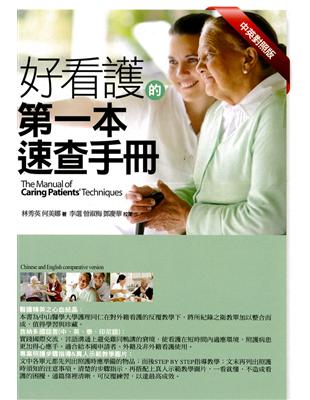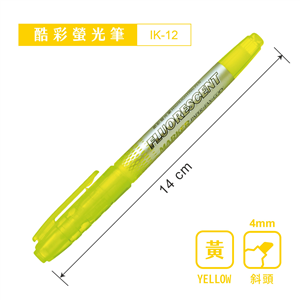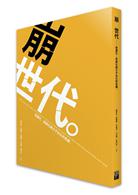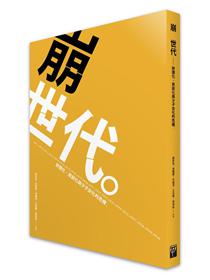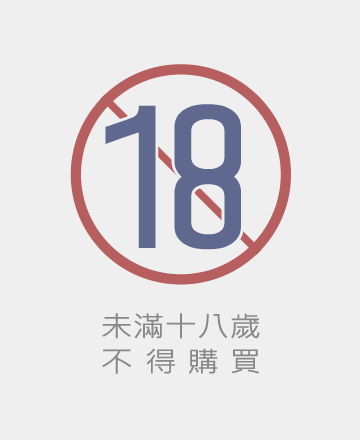據行政院最新數據統計顯示,臺灣已正式邁向高齡化社會,如何照料及安排銀髮族的生活起居已成為我們勢必關切的重要議題。
近年來,申請外籍看護以全天候照料親屬,是目前多數人選擇的照護方式之一。然因申請過程多半倉促,來臺外籍看護身處陌生環境,民俗文化的不同,加上語言隔閡等因素,間接導致照護時發生的障礙與不便。
有鑑於此,為使看護照護更加得心應手,快速適應本國環境,本書特就外籍看護常用語言,將指導看護實作筆記分別翻譯成英文、印尼文及泰文等三種語言呈現,以減少醫護同仁與外籍看護在語言溝通上的困擾,避免護理人員教導時產生困難,加強外籍看護照護的能力,進而提高看護的照護品質。
【本書特色】
*醫護精英之心血結晶:
本書為中山醫學大學護理同仁在對外籍看護的反覆教學下,將所紀錄之衛教單加以整合而成,值得學習與珍藏.
*含納多國語言(中、英、泰、印尼語):
實踐國際交流,言語溝通上避免雞同鴨講的窘境,使看護在短時間內適應環境,照護病患更加得心應手。適合給本國申請者、外籍及非外籍看護使用。
*專業照護步驟指導&真人示範教學圖片:
文中各單元都先列出照護時應準備的物品;而後STEP BY STEP指導教學;文末再列出照護時須知的注意事項。清楚的步驟指示,再搭配上真人示範教學圖片,一看就懂,不造成看護的困擾。通篇條裡清晰,可反覆練習,以達最高成效。
作者簡介:
●林秀英
現任:私立仁愛之家附設靜和醫院護理主任
學歷:中山醫學大學護理研究所碩士
弘光科技大學護理系學士
經歷:光雄醫院內科並防護理長
中山醫學大學附設復健醫院護理長
中山醫學大學附設醫院出院準備服務護理師
●何美娜
現任:中山醫學大學附設復健醫院臨床護理師
學歷:弘光科技大學護理系學士
經歷:中山醫學大學附設復健醫院出院準備服務護理師
各界推薦
名人推薦:
中山醫學大學附設復健醫院於民國七十八年開始營運,至今已將近十六年,復健科病房有九十三床,腦中風、腦傷以及脊髓損傷的重殘患者就占了八、九成。在患者復健早期或甚至是終身常需要一位全天候的照顧者,因此在家屬之外,常需要僱用其他照顧者來幫忙。由於經濟的因素,不少家庭不得不僱用外籍看護工來幫忙。外籍看護工雖然接受過基本的語言及照護訓練,但是照顧重殘的病患時,仍然有許多需要學習的看護技巧。本院例行性會在床邊或者舉辦各種衛教課程,來提高患者、家屬及照顧者對傷病的認知,以及學習正確的照護技巧。近幾年大量外籍看護加入照護的行列,由於民俗文化不同、語言的隔閡,造成教導上嚴重的障礙。偶爾有翻譯人員來院時,我們會請他們幫忙溝通。由此而產生一個靈感,何不將我們平常已經做好的中文衛教單張,做一些增補,然後翻譯成各種外籍看護的本國語言,減少護理人員教導上的困難,提高看護工的照護品質。
經過本院護理部與出院準備小組的努力後,很快的就完成了中文衛教單張的製作。接下來是尋求各種常用語言(英文、越南文、泰文、印尼文)翻譯師來進行翻譯,幾經波折,最後由豐田國際開發有限公司翻譯師協助完成。之後又面臨經費以及編印排版的困難,經過院內同仁的多方努力,花了四年時間,方才完成四種外籍語言的衛教單張印製。
首先在本院試用,護理同仁覺得語言溝通的困擾減少了,經過反覆的示範教學後,外籍看護工的照護技巧果然有明顯的進步。之後,我們把這些衛教單張提供給其他醫療院所使用,得到很好的反應。因此,決定翻印成《病患照護技巧手冊》,希望資源共享,能造福更多的醫療院所、看護人員以至於患者。
在此特地感謝本院護理部以及出院準備服務小組同仁們的熱心與努力!
中山醫學大學附設復健醫院院長
畢柳鶯
名人推薦:中山醫學大學附設復健醫院於民國七十八年開始營運,至今已將近十六年,復健科病房有九十三床,腦中風、腦傷以及脊髓損傷的重殘患者就占了八、九成。在患者復健早期或甚至是終身常需要一位全天候的照顧者,因此在家屬之外,常需要僱用其他照顧者來幫忙。由於經濟的因素,不少家庭不得不僱用外籍看護工來幫忙。外籍看護工雖然接受過基本的語言及照護訓練,但是照顧重殘的病患時,仍然有許多需要學習的看護技巧。本院例行性會在床邊或者舉辦各種衛教課程,來提高患者、家屬及照顧者對傷病的認知,以及學習正確的照護技巧。近幾年大...
章節試閱
CH6 How to conduct swallowing training and feeding?
如何進行吞嚥訓練及餵食
To eat with your own mouth is the greatest happiness in life.What a wonderful thing it is to taste delicious delicacies! However,people might have to eat food through a nasogastric tube temporarily due to illness. Such a tube can be dispensed along with the improvement in health condition of the patient or be utilized as a channel to digest the food that the patient’s mouth can’t eat. Nevertheless, you are responsible to train the swallowing ability of the patient before he/she can eat food through his/her mouth by himself/herself.
能夠從口吃東西,是人生至大的快樂,如果一個人能保有由口享受美味大餐的能力,該是多美好的一件事!病患可能因病暫時以鼻胃管補充養分,但是這管子是可以隨病情改善而拔除或只補充由口所沒辦法吃的食物,不過在讓病患成功的由口吃東西前,需要您訓練他(她)吞東西的能力。
一、When to train him/her to swallow
何時可訓練他(她)吞嚥東西
When the patient gives response to linguistic stimulus and
won’t cough after you dip a cotton swab with water to let him/her
swallow, you may begin training.
如果病患開始對語言刺激有反應,並以棉籤沾水讓病患吞嚥,無咳嗽發生,即可以開始訓練。
二、Things to prepare
您需要準備的用物
1.A towel (to wrap around the body).
毛巾(圍在身上)。
2.Food: Jellies, pudding and bean jellies are the best choices at the beginning of swallowing training. General soft or liquid food can be tried later.
食物:吞嚥訓練初,宜採用果凍、愛玉、布丁、豆花等,成功後可採用一般軟質或液體食物。
3.A food container and a little spoon.
裝食物容器及小湯匙。
三、Procedure
步驟
1.A quiet dining atmosphere should be maintained. Concentrate on feeding.
維持進餐環境安靜,將注意力集中在進食上。
2.Help the patient up at 60-90°. Put a pillow behind the patient’s
head and place a towel under his/her chin. In this way, a comfortable dining posture is achieved.
協助病患起身至60-90 度,以枕頭放頭後,毛巾置於臉頰下,維持舒適的進食姿勢。
3.Let the patient see the food with his/her own eyes to stimulate appetite and excretion of digestive juice.
讓其親眼看見食物,以增加病患食慾,促進消化液之分泌。
4.Feed the patient with a small bite each time and repeat your command of swallowing the food two times.
以口令重複動作,餵一小口食物,並請病患吞嚥兩次進行。
Command
口令
Open your mouth and taste it. Use your tongue to lift thefood to your palate. Draw back your chin and swallow. You may use your hands to assist the patient during the training.(This step is not necessary for patients without swallowing problems.)
打開您的嘴巴,嚐一嚐,用您的舌頭將食物舉至上顎,縮下巴吞下去,其間可用手協助病患(吞嚥無問題的病患可省去此步驟)。
5.Feed the patient in a slow pace and get a proper amount of food every time. For patients having a cerebrovascular accident, food should be placed into the mouth on the healthy side.
餵食時要緩慢,每次送入病患口中的食物份量應適中;如腦中風的病患應將食物放入健側口中。
6.Food ought to be put into the mouth of the patient precisely and another serving can’t be given until you make sure the patient has chewed and swallowed it. Write down patient’s condition while swallowing, the amount and type of food fed and any special situations.
食物應準確放入於其口內,需確定病患已咀嚼吞入後才可再餵食。並記錄吞嚥情形、進食的量與種類,及特別情形之發生。
四、Points for attention
注意事項
1.Stop feeding once the patient starts to cough. Try to feed the patient at least in half an hour. If the patient keeps coughing,feeding should be suspended some time.
當病患發生咳嗽時,請停止餵食,讓病患至少休息半小時後再試。若屢次發生,則可能病患需延後一段時日再試。
2.The patient should sit while being fed and take a rest for 30 minutes before lying down again to prevent food from flowing back.
餵食後需採坐姿休息半小時,再臥床,以防食物逆流。
3.The nasogastric tube or other device needs to be kept during feeding training to supplement water and nutrition.
訓練期間,仍應有鼻胃管留置或其他方式,以補充不足的水分及營養。
4.Start to feed the patient with liquid food after soft food has been fed for some time.
軟質食物進行一段時日,才可進行液體食物餵食。
CH14 Spit stroking and Postural Drainage
拍痰及姿位引流
Once the respiratory tract is obstructed by phlegm (sputum),human life could be in danger. Therefore, it’s very important to take care of his respiratory tract to keep it unobstructed. Besides phlegm (sputum)pumping, phlegm stroking and postural drainage are more useful ways to clear up phlegm (sputum) deep in the lung so as to make breathing smoothly.
一旦呼吸道被痰液堵住會威脅生命,因此照護病患的呼吸道是非常重要的,維持呼吸道通暢除了靠抽痰外,藉著拍痰及姿位引流的方式能更有效清除病患肺深部的痰
液,使病患的呼吸更順暢。
一、Phlegm stroking
拍痰
Stroke the chest on the surface to reduce the amount phlegm(sputum) adhering to trachea wall so that phlegm can be easily coughed out to keep the breathing more smoothly.
叩擊胸部表面,可減少痰液附著於氣管壁,使痰液易於咳出,讓呼吸更順暢。
二、Steps
步驟
1.The caretaker draws his fingers close to make the palm like a cup.
照顧者手指併攏,使手掌呈杯狀。
2.Relax the shoulders and use the strength of the wrist to stroke the back in rhythms.
放鬆肩部,利用手腕的力量,有節奏的叩擊背部。
三、Postural drainage
姿位引流
Consult the doctor or the family nurse to confirm the phlegmatic area of the lung, then make use of the principle of gravity to make the phlegm flow toward the main bronchial tube or the trachea so that the phlegm can be easily coughed out or aspirated.
請教醫師或居家護理師,確定肺部痰多的區域,利用重力的原理,使痰液流向主支氣管或氣管,以便於咳出或抽吸。
四、Steps
步驟
1.Prepare a soft pillow or quilt.
準備軟枕或棉被。
2.Raise the nidus. If the nidus is the upper or middle lobe of the lung, turn the body to the left or the right side and give a support, then operate phlegm stroking for 10-15 minutes.
將病灶部位抬高。肺部上葉及中葉,向左或向右側翻並給予支托,可配合拍痰10-15 分鐘。
3.If the nidus is either side of the lower lobe of the lung, place a soft pillow or quilt under the hips, then place a soft pillow under a shoulder to turn the body to the right or left side.
肺部兩側下葉,利用軟枕或棉被,將臀部墊高,一側肩部置一軟枕,向左或向右側翻。
五、Attention
注意事項
1.The operations mentioned above are not allowed to be made 30 minutes before and one hour after meal.
以上活動不能於餵食前30 分鐘及飯後1 小時內施行。
2.When it’s not proper to pose the patient in special way of lying in case of hypertension or special conditions, it’s proper and effective to turn the patient to the left or right side.
若有高血壓病患或特殊狀況(醫師認定)不宜擺特殊臥位時,左、右側翻亦有不錯成效。
3.Stop the operation immediately when the patient shows uncomfortable
signs such as quick breathing or blushed.
施行時,若有不適狀況,如呼吸加快、臉色潮紅等應立即停止。
CH6 How to conduct swallowing training and feeding?
如何進行吞嚥訓練及餵食
To eat with your own mouth is the greatest happiness in life.What a wonderful thing it is to taste delicious delicacies! However,people might have to eat food through a nasogastric tube temporarily due to illness. Such a tube can be dispensed along with the improvement in health condition of the patient or be utilized as a channel to digest the food that the patient’s mouth can’t eat. Nevertheless, you are responsib...
目錄
皮膚照護/
Skin care
如何給予病患洗頭/
Hair washing
口腔清潔與洗臉/
Dental and facial care
如何清潔病患的手和腳/
Hand and feet care
病患正確的給藥/
Give medicine to accurately
如何進行吞嚥訓練及餵食/
How to conduct swallowing training and feeding?
如何由鼻胃管灌入食物/
How to conduct nasogastric feeding?
如何給予病患正確的換藥/
How to change dressings correctly?
如何從病患的氣切造口抽痰/
How to suck the phlegm (sputum suction) from the tracheostomy?
如何照顧病患的呼吸道/
How to take care of the respiratory tract (airway) of a patient?
矽質氣切管居家清潔消毒方法/
Trachea tube cleaning and sterilizing
蒸氣吸入操作/
Vapor treatment (Steam inhalation)
如何清潔病患的氣切造口/
How to clean his tracheostomy?
拍痰及姿位引流/
Spit stroking and postural drainage
如何給予臥床的病患進行關節運動/
How to conduct mobilization for bed-ridden patients?
膀胱訓練方式/
Bladder training
如何照顧病患的尿管及尿袋/
How to care for the patient's catheter and urinary drainage
bag?
大便訓練衛教單/
Bowel training
癲癇患者發作之處理/
How to deal with an epileptic patient?
預防跌倒需知/
Notice for preventing falls
皮膚照護/
Skin care
如何給予病患洗頭/
Hair washing
口腔清潔與洗臉/
Dental and facial care
如何清潔病患的手和腳/
Hand and feet care
病患正確的給藥/
Give medicine to accurately
如何進行吞嚥訓練及餵食/
How to conduct swallowing training and feeding?
如何由鼻胃管灌入食物/
How to conduct nasogastric feeding?
如何給予病患正確的換藥/
How to change dressings correctly?
如何從病患的氣切造口抽痰/
How to suck the phlegm (sputum suction) from the tracheostomy?
如...
購物須知
退換貨說明:
會員均享有10天的商品猶豫期(含例假日)。若您欲辦理退換貨,請於取得該商品10日內寄回。
辦理退換貨時,請保持商品全新狀態與完整包裝(商品本身、贈品、贈票、附件、內外包裝、保證書、隨貨文件等)一併寄回。若退回商品無法回復原狀者,可能影響退換貨權利之行使或須負擔部分費用。
訂購本商品前請務必詳閱退換貨原則。




